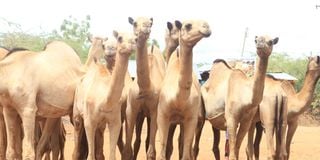Mysterious camel disease outbreak hits Marsabit, killing 20 in a week

A herd of camels.
A mysterious camel disease has struck Hurri Hills in North Horr Constituency, Marsabit County, killing at least 20 camels within a week and leaving dozens more critically ill.
The outbreak has triggered panic among herders, who now fear devastating losses unless urgent veterinary intervention is deployed.
“We appeal to government vets and other experts to come to the rescue of our camels before we lose all of them,” said Hurri Hills Senior Chief Bonaya Godana in a phone interview with Nation.
“Despite our desperate attempts to reach veterinary doctors, logistical challenges have stalled any response.”
At least 20 other camels are reported to be in critical condition, raising fears the toll may rise.
While no definitive diagnosis has been made, local suspicion points to a possible bacterial or viral infection.
Symptoms
The disease presents with symptoms including thick white nasal discharge, laboured breathing, teary eyes, extended neck, swollen cervical and parotid lymph nodes, immobility, and eventual death within three to four days.
Veteran herder Mzee Dido Guyo said he lost nine camels between March 16 and March 20, while three other herders lost a combined 11 animals.
“We wonder what will become of our families if we lose even the few animals that survived the devastating drought,” lamented Mzee Guyo, who said four of his remaining camels are in critical condition. With 12 children—four in university and three in high school—he fears the loss of income and milk could push his household into starvation.
Camel milk is a lifeline in the region, particularly for children and the elderly. The disease has cut off that crucial supply, exacerbating food insecurity and malnutrition.
Hurri Hills was among the areas worst affected by the 2021–2022 drought, which wiped out hundreds of livestock and left families grappling with acute malnutrition, school dropouts, and mental health issues.
Familiar outbreak
Similar unexplained camel deaths were reported in 2024 in Korka sub-location, where at least 195 camels—mostly pregnant—died or suffered stillbirths.
In 2020, residents in El Hadhi lost around 100 camels after the animals drank contaminated water from an abandoned well.
In past outbreaks along Kenya’s borders with Ethiopia and Somalia in 2020 and 2022, camels were diagnosed with Mannheimia haemolytica, a bacterial infection affecting the lungs.
Other causes of past deaths have included hypothermia triggered by sudden weather changes, where extreme heat followed by downpours caused frostbite-like symptoms in livestock.
According to a 2015 Oxfam report, Hurri Hills lost more than 300 animals—including camels, cattle, and goats—during a similar outbreak that caused drooling, limping, and eventual death.
Previous regional responses to such outbreaks led to meetings among representatives from Kenya, Ethiopia, Somalia, Uganda, and Djibouti, resulting in the creation of a cross-border disease task force and standard methods for diagnosis and control of zoonotic diseases.
Despite these initiatives, residents say they feel neglected.
“We need government intervention now,” Chief Godana urged. “Our livelihoods and lives depend on these animals.”


